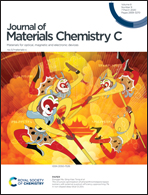Nondoped organic light-emitting diodes with low efficiency roll-off: the combination of aggregation-induced emission, hybridized local and charge-transfer state as well as high photoluminescence efficiency†
Abstract
In this study, two isomers, namely 2P-BT-N-2TPA and 2TPA-BT-N-2P, have been designed and synthesized with hybridized local and charge transfer (HLCT) properties. 2TPA-BT-N-2P has been found to have not only stronger intra/intermolecular interactions with regular molecular packing, which stabilized the excited-state configuration, but also aggregation-induced emission enhancement (AIEE) properties. The AIEE properties can effectively inhibit the aggregation-caused quenching (ACQ) effects in the aggregation state and its photoluminescence quantum yield (PLQY) is up to 91%, which is extremely high in a solid-state film. When 2TPA-BT-N-2P is applied as a dopant to form a doped OLED, the device exhibited an excellent external quantum efficiency (EQE) of 6.6%, with an emission peak of 588 nm. Moreover, when 2TPA-BT-N-2P is applied as a pure emitting layer to form a non-doped OLED, the device still achieved an EQE of 5.8% and 5.1% at 100 cd m−2 and 1000 cd m−2, respectively, with the lowest efficiency roll-off currently reported from the HLCT molecule in the orange emission.



 Please wait while we load your content...
Please wait while we load your content...